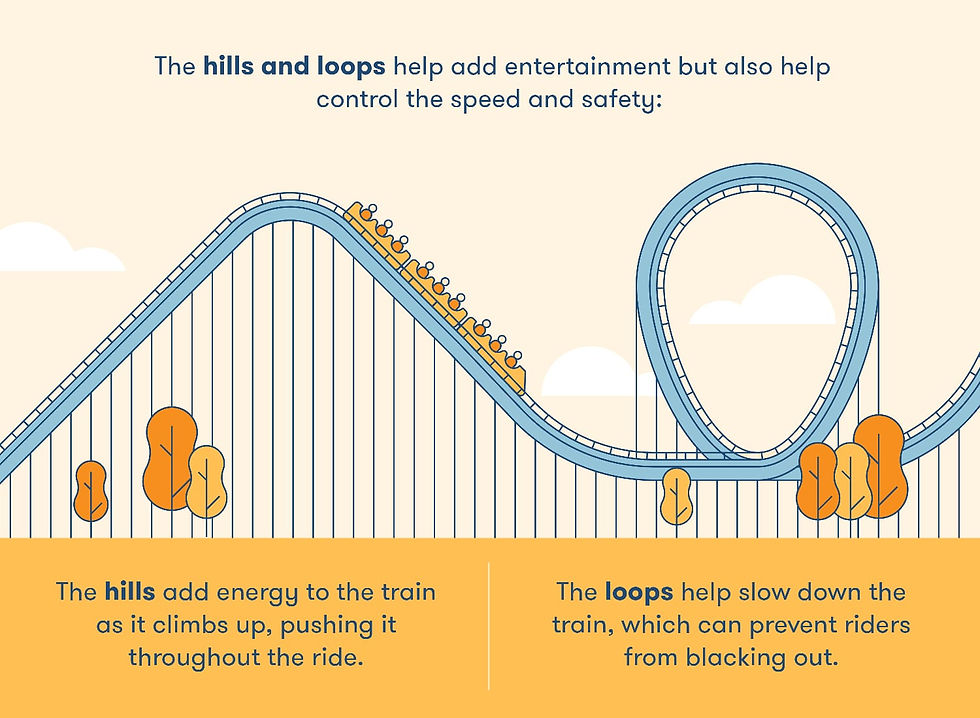Rollercoaster Engineering- Physics behind the twists and turns
- Eureka WSRC
- Sep 21, 2021
- 5 min read
Updated: Sep 27, 2021
The basic principles of physics play a subtle yet significant role in our daily lives quite more frequently than one might recognize. Rollercoasters are a perfect display of combining physics with adrenaline filled inversions to provide its riders with anticipation as well as momentary freefall experiences. Regardless of the overall experience lasting for mere minutes, rollercoasters use a wide collection of fundamentals like hydraulics mechanisms, energy and power conversions as well as electromagnetic propulsion systems. The difference in design and manufacturing varies between rides as per the engineer’s choice or objective on what riders must feel during their experience.

Launch Mechanism
Despite the numerous variations and inversions found in modern rollercoaster designs the ride mainly start off with either the ‘lift hill’ using the chain lift mechanism or rapid propulsion which utilizes the concept of either fluid hydraulics or pneumatic launches. However, others systems such as LIM (Linear induction motor) and LSM (Linear synchronous motor) are still utilized for initial acceleration. In the earlier periods, conventional methods of gaining acceleration during launch from an elevated platform would be performed using a push-car connected to a cable wrapped around an electrical winch, behind the ride’s train. When launched, the push-car would be pulled due to the winch winding in the cable which in turn, would push the train along the tracks. Another famously alternative method didn’t require an elevated platform; it instead needed a more powerful launch as it didn’t relay on gravity so a counterweight connected to a catch-car by a series of pulleys was utilized. The new design addition also relied on a flywheel which is a large heavy spinning disk that aided in acceleration. The major drawback of mechanical wear arose giving the conventional chain ‘lift hill’ technology a limitation and increasing its maintenance cost. This in turn created a whole new type of launch systems that didn’t lean on contact. The ideology of electromagnetism was applied in the LIM (Linear induction motor) and LSM (Linear synchronous motor) mechanisms which pushed the coaster around the track at specific moments making it efficient. The gap left in-between the middle of each set of magnets is supplied with AC current to create a magnetic field. This magnetic field creates a wave or an eddy current for the metal fin attached to the bottom of the coaster, as it passes thru the gaps in between the set of magnets, causing propulsion down the track. The advantage of LIM is that it can reverse its polarity so the coaster can travel backwards. However, LSM uses strong and permanent magnets attached to the coaster to create a forward pull. These coasters magnets get attracted to the track-magnets causing a forward acceleration however, the moment they are passing over the track-magnet’s
polarity is revered causing repulsion and pushing the coaster down the track. The continuous switching of trach-magnets must be orchestrated in a timely manner using computers and electricity to achieve the desired top speed. Compressed air or pneumatic launches were originally used for drop tower rides but were however later incorporated into rollercoaster launch system designs operating on compressed air stored in two cylindrical tanks within the ride’s tower or peak structure. Compressors would pump air into either one of the tanks to cause rise in pressure while being connected to the other tank, which has a piston, thru a valve. The piston present in the other tank has a cable and pulley arranged connecting to a catch-car which holds onto the train upon contact. Launch is initiated once the compressed air is released into the other tank with a piston pushing it upwards along with the ride. After the air rushes to fill the space and reach an equilibrium state making it less compressed.

Soon after the hydraulics were used to reach top speeds faster and this worked similar to the pneumatics system except it used large volumes of hydraulic fluids. In the ride’s launch building several cylinders are filled with hydraulic fluid pushed into using pumps. Each cylinder consists of one side of nitrogen gas divided by the other side having hydraulic fluid. As hydraulic fluid is incompressible, the nitrogen gas gets compressed instead when the fluid is pumped in. Pressure is built up within the cylinder. A second tube with an initially closed valve helps by connecting a motor to the hydraulic side of the cylinder. This sub system is then replicated to form the main system which is then connected to a large central winch drum. This drum is wrapped around with a cable that is attached to a catch car. When the cylinders are pressurized, the connecting valve opens so the compressed nitrogen from one side pushes against the piston forcing the hydraulic fluid to go through the motors causing the winch drum to rotate. This creates a rotational motion winding the cables therefore pulling the coaster along the track at an accelerating speed.
Rollercoaster Elements And Forces
Engineers make sure riders experience a unique variety of sensations as they cover each inversion; all specifically designed to provide a safe yet ingenious way of manipulating forces to its maximum
advantage. A numerous number of forces work together at every stage of a rollercoaster ride; ranging from twists and turns to steep drops and loops.

The ride starts off with the chain ‘lift hill’ machinery which relies on gaining potential energy by lifting the train to the highest point in the ride; this ‘built-up’ potential energy is then converted into kinetic energy as gravity takes over when the coaster goes back down the hill to complete the numerous inversions in a continuous cycle of energy conservation as well as energy loss due to friction. Therefore, engineers make sure the initial potential energy can never be exceeded by friction generated. During a loop riders undergo the influences of centripetal force where they are subjected to feeling an inward force due to the smooth circular part of the track. However, a certain amount of acceleration is required before the track extends to a loop however, to prevent excessive acceleration at the sides in a teardrop-shaped loop the track is designed in such a way that it is larger at the bottom and sides while it is smaller at the top. G force or gravitational force is a measurement of acceleration and therefore, gives us a perception of weight causing feelings of weightlessness or multiples of our normal weight during steep drops or 360 rolls. Guests undergo experiences of various g-force types acting in different directions. The first one called linear g-force which acts in the forward and backward direction which occurs during increase and decrease of speed especially during launch. Riders are subject to linear g-force as their body is pushed
backwards while the coaster accelerates forwards, on the other hand deceleration is experienced during brake run which is another example of a linear g-force. Positive and negative g-forces are the second type acting in the upwards and downwards directions through a change in elevation. Positive g-force is felt by riders in valleys as direction occurs downwards or sections of track which continuously angle towards the upwards direction. Negative g-forces provide the opposite sensation during crests which pull the coasters down keeping them secured to the track. The phenomenon called ‘airtime’ occurs here where riders rise up or out of their seats and have to be kept intact by restrains. The final g-force type is lateral which occur side to side or from left to right direction and is experienced during sharp track turns especially unbanked ones like wild mouse coasters where riders are thrown side to the coaster while it moves in the opposite direction.
THE FUTURE OF ROLLERCOASTERS
The only limiting factor in future developments of rollercoaster technology is the human body. Due to
recent exponential surge in technology, virtual reality provided with headsets can break the boundaries as well as provide riders with an added level of visual simulation and illusion.
Aaditi Rammohan
------------------------------------------------------------------------------------------------------------------------------------------------------------------------------------------------------------------------
Citations
Sites:
https://www.scientificamerican.com/article/paper-roller-coasters/
https://www.physicsclassroom.com/class/circles/Lesson-2/Amusement-Park-Physics
https://science.howstuffworks.com/engineering/structural/roller-coaster5.htm
https://www.physicsclassroom.com/mmedia/circmot/rcd.cfm
http://teachers.dadeschools.net/jkaelin/g-forces.htm
https://themeparks.lovetoknow.com/Physics_of_Roller_Coasters
https://www.learner.org/wp-content/interactive/parkphysics/glossary.html
https://science.howstuffworks.com/engineering/structural/roller-coaster3.htm
https://physicsworld.com/a/twists-turns-thrills-and-spills-the-physics-of-rollercoasters/
https://www.teachengineering.org/lessons/view/duk_rollercoaster_music_less
Videos:
https://www.youtube.com/watch?v=ZKJX7oGpj8g – Roller Coaster Elements: explained
https://www.youtube.com/watch?v=rPTL_PXo0oY&list=RDLVJ8pJiV44hVM&index=17 - Roller Coaster
Launches: Explained
https://www.youtube.com/watch?v=6AzHwNLxl_4 – Roller Coaster Forces: Explained
https://www.youtube.com/watch?v=J8pJiV44hVM&list=RDLVJ8pJiV44hVM&start_radio=1&t=200s – The
Physics of Roller Coasters
https://www.youtube.com/watch?v=b81gXvFLdrk – The History of Launched Roller Coasters







Comments